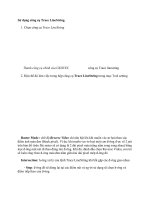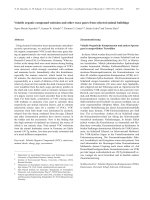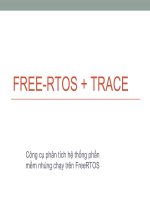Trace minerals
Bạn đang xem bản rút gọn của tài liệu. Xem và tải ngay bản đầy đủ của tài liệu tại đây (1.05 MB, 43 trang )
Trace Minerals
Minerals in the Body
The Trace Minerals
Needed in much smaller amounts
Are essential
Difficult to study due to the trace amounts
needed by the body
Food content dependent on soil content
Animal sources of mineral are generally
better absorbed.
Iron
Found in minute amount in every cell
15% is absorbed
Heme iron Vs. Nonheme iron
– 40% of iron in animal flesh is heme
iron
– Heme iron is better absorbed than
nonheme
Vitamin C enhances absorption
Absorption of Iron
Determined by body’s need
Acidic environment
Upper small intestine is absorption site
Hindered by phytic acid, oxalic acid,
high fiber, high calcium, polyphenols
Zinc competes with iron for absorption
Functions of Iron
Hemoglobin in red blood cells
– Transports oxygen and carbon dioxide
– High turnover, high demand for iron
Myoglobin in muscle cells
– Binds oxygen
Electron transport chain
Enzyme cofactor
Immune function
Drug-detoxification pathway
Iron-Deficient Anemia
Most common form of anemia (30% of
world population)
Low levels of hemoglobin and hematocrit
Insufficient intake and storage
Reduction in the production of red blood
cells and oxygen capacity
Infants, toddlers, chronic blood loss,
vegans, runners, and women of
childbearing years are most at risk
Paleness, brittle nails, fatigue, difficulty
breathing, poor growth
Food Sources of Iron
Red meats
Enriched grains
Fortified cereals
Iron skillet
Milk is a poor source
Iron Pyramid
Nonheme Iron
Not as well absorbed
Found in animal flesh, eggs, milk,
vegetables, grains and other plant
foods
Better absorbed if eaten along with
sources of heme iron
Iron Needs
RDA is 8 mg/day for adult male
RDA is 18 mg/day for female age 11
to 50; 8 mg after 50
Assumes that 18% of dietary iron is
absorbed
Average American diet: females 12
mg/day; males 17 mg/day
Average intake exceeds RDA for men,
low for women
Toxicity of Iron
Can be serious, especially for children
Diarrhea, constipation, nausea, abdominal
pain
Upper Level is 45 mg/day
Causes death due to respiratory collapse
(shock); liver damage
Alcohol increases absorption, damages
mucosal cells
Hemochromatosis
Genetic
disease (carrier can also
over absorb)
Iron deposit which can lead to
organ damage
May go undetected until 50-60
years of age when organ fails
Zinc
Essential
nutrient
Better absorption from animal
source
Deficiencies cause growth
retardation and poor sexual
development
Absorption of Zinc
Influenced by the foods consumed
40% of zinc from an animal source is
absorbed if body’s needs are great
Dependent on body’s need
Presence of phytic acid decreases
absorption
Calcium supplement decreases zinc
absorption
Competes with copper and iron absorption
Functions of Zinc
Cofactor to many enzymes
Synthesis of DNA, RNA
Protein metabolism, cell membrane
Wound healing, immune function,
growth
Development of sexual organs and
bones
Insulin function
Component of superoxide dismutase
Zinc Deficiency
Growth retardation
Slow sexual maturity
Loss of taste
Lethargy, emotional disorders
Slow wound healing
Food Sources of Zinc
Animal products
Shellfish
Legumes
Not part of the enrichment process
RDA for women is 8 mg/day
RDA for men is 11 mg/day
Daily value is 15 mg
Average intake is marginal for women and
adequate for men
Toxicity of Zinc
Upper Level is 40 mg/day
Inhibits copper absorption
Reduces HDL
Increases risk of heart disease
Diarrhea, cramps, Nausea, vomiting
Depressed immune function
Do not exceed 100 mg/day without medical
supervision
Some take for sore throats, colds
Selenium
Readily absorbed
Excreted through the urine and feces
Co-factor for glutathione peroxidase
Protects the heart and other cells from
oxidative damage
Works together with vitamin E
Cancer prevention
Deficiency of Selenium
Muscle
pain
Muscle wasting
Cardiomyopathy
Food Sources of Selenium
Fish, meat (organ meat), egg, milk,
shell fish
Grains, seeds, nuts dependent on soil
content
RDA for adults is 55 ug/day
Average intake exceeds RDA
Toxicity of Selenium
Upper Level is 400 ug/day
Garlicky breath
Hair loss
Nausea, vomiting
Weakness
Rashes
Cirrhosis of the liver
Iodine
Found in an ion form, iodide
Used for thyroid hormone synthesis
Regulates metabolic rate, growth,
development
Thyroid gland enlarges (goiter) with
low intake of iodide
Cretinism is the stunting of fetal
growth and mental development as a
result of low iodine diet
Food Sources of Iodine
Iodized salt (1/2 tsp. meets RDA for
iodine)
Saltwater fish, seafood, dairy, grains
Sea salt is a poor source (loss during
processing)
Plant source dependent on soil content
RDA for adult is 150 ug/day (50ug to
prevent goiter)
Average intake exceeds RDA









